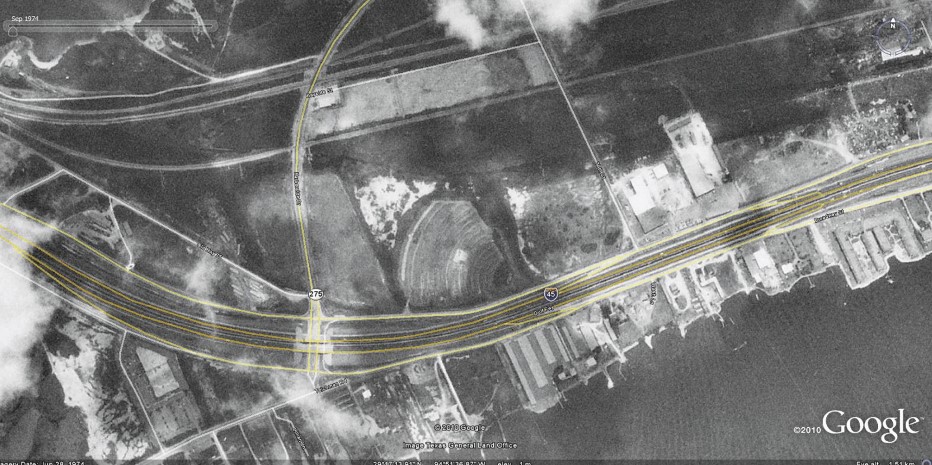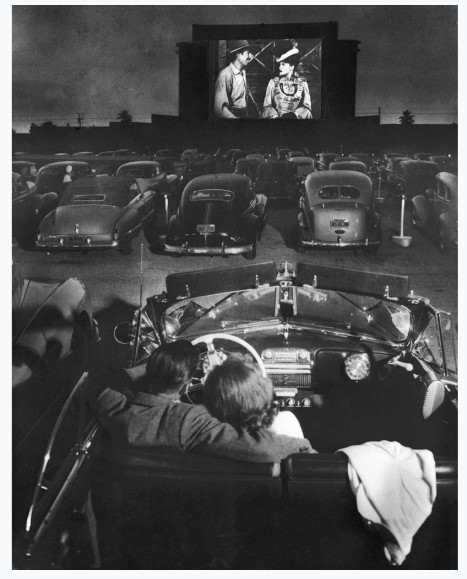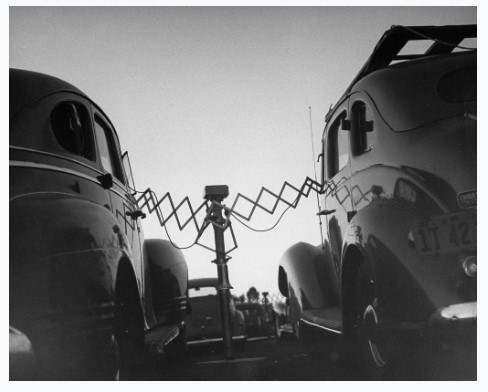The drive-in movie theater was once a marvel of technology, and then it was its victim. The seemingly ingenious revolution in entertainment that brought the latest cinematic thrills right to the comfort and privacy of your car understandably succumbed to a population that quickly became addicted to air conditioning. Nevertheless time romanticizes all things, and every generation since has known the phantom pains of yearning for an experience they will never have—like hiding in the trunk of a hot car to avoid paying for a ticket, or burning citronella on the dashboard to ward off mosquitoes.
The popularity of drive-ins peaked in the mid-1950s and during that time Texas led the nation with over four hundred of them scattered all across the state, an average of one every six hundred square miles.
But long before mid-century, Galveston became one of the first cities in the nation with an outdoor cinema; the Drive-In Short Reel Theatre opened on July 5, 1934. It was only the third one of its kind in the United States, and its successor would prove to be equally groundbreaking. When the Oleander Drive-In Theatre held its debut performance on the Island in 1951, its modern facilities were the talk of Texas.

Located north of Broadway just off of 77th Street with an entrance at Highway 75 (Now Highway 275 or Harborside Drive), the Oleander Drive-In Theatre was the product of Interstate Circuit, Inc., known informally as Interstate Theaters. Based in Dallas, the business of Interstate Theaters had evolved over its many years of existence, having first come to Galveston when it was booking vaudeville acts at a local live theatre. It would become one of the pioneers of the drive-in cinema in Texas, however, opening thirty locations in a twelve year span, including Houston, San Antonio, Austin, Dallas, and Fort Worth.
 In Galveston, the latest and greatest Oleander sprawled across fifteen acres and boasted an “all-weather paved parking area” that could accommodate eight hundred automobiles. With some expert engineering and clever use of ramps and tiers, every parking space had a perfect sight-line to the larger-than-ever screen.
In Galveston, the latest and greatest Oleander sprawled across fifteen acres and boasted an “all-weather paved parking area” that could accommodate eight hundred automobiles. With some expert engineering and clever use of ramps and tiers, every parking space had a perfect sight-line to the larger-than-ever screen.
The screen was beholden to a projection booth which operated at the height of known technology and offered the brightest, most clear-cut image of its time. Out of that booth was also sent the latest in sound engineering that regulated the output sent to the individual car speakers, dangling from a post at each parking space.
The family-friendly atmosphere was amplified by a fenced-in playground in front of the screen, complete with comfortable chairs where parents could sit. The Oleander also generously offered a bottle-warming service for infants, in the hopes that a baby’s feeding schedule would not interfere with a mother’s desire to see a movie.
A spacious patio was situated in the center of the parking area for patrons who preferred to sit outdoors, and nearby was the deluxe snack bar that served up a smorgasbord of concessions including all of the traditional candy, popcorn, hot dogs, and soda, as well as cigars and cigarettes. It was also the only place around that served a new concoction and an Interstate trademark—popcorn with a “special cream butter.”
Even the basics were given special attention at the Oleander Drive-In. The all-tile restrooms and refrigerated drinking fountains were borderline luxurious.
Just before 7pm on May 25, 1951, the traffic was backed up for miles down the highway with patient moviegoers eager to be the first to experience “The South’s Finest Drive-In Theatre.” Ticket prices were 50¢ for adults, 9¢ for children. A short opening act courtesy of Donald Duck and his animated antics was followed by the opening night feature, September Affair starring Joseph Cotton and Joan Fontaine. The night ended with a fantastic, celebratory display of fireworks.
 For the next eight years, Oleander Drive-in featured two shows nightly, rain or shine, and listeners could tune to KGBC “The Voice of Galveston” for the latest information on the new programs that changed every Sunday, Tuesday, Thursday, and Saturday. Graced by the visages of 1950s stars and starlets such as Doris Day, Marilyn Monroe, Charlton Heston, and Yul Brynner, the Oleander was always one of the first to debut the latest hits of Hollywood.
For the next eight years, Oleander Drive-in featured two shows nightly, rain or shine, and listeners could tune to KGBC “The Voice of Galveston” for the latest information on the new programs that changed every Sunday, Tuesday, Thursday, and Saturday. Graced by the visages of 1950s stars and starlets such as Doris Day, Marilyn Monroe, Charlton Heston, and Yul Brynner, the Oleander was always one of the first to debut the latest hits of Hollywood.
Galveston’s only drive-in theatre enjoyed a brief but memorable reign. Ticket prices began to go up, peaking at $1.25 for adults and 50¢ for children, but demand was waning by the end of the decade.
The Oleander closed in 1959, but in 1960 reports emerged suggesting that plans of a remodel were under discussion. By that time the trend was already on a steep decline both state- and nationwide, then Hurricane Carla struck in 1961, rendering the property irreparable and the venue of an era obsolete.
In 1962, Interstate Theaters informed Galveston Mayor and City Council that the time, water, and wind-ravaged theatre would at last be dismantled. The massive screen tower, business office, fence, and speakers were all to be removed. The concession stand would remain; the space was being leased by Maco Stewart of Stewart Mansion fame who was using the building as his campaign headquarters during his run for state senate.
Today, the location of Oleander Drive-In is unrecognizable as the site of Classic Auto Group of Galveston.